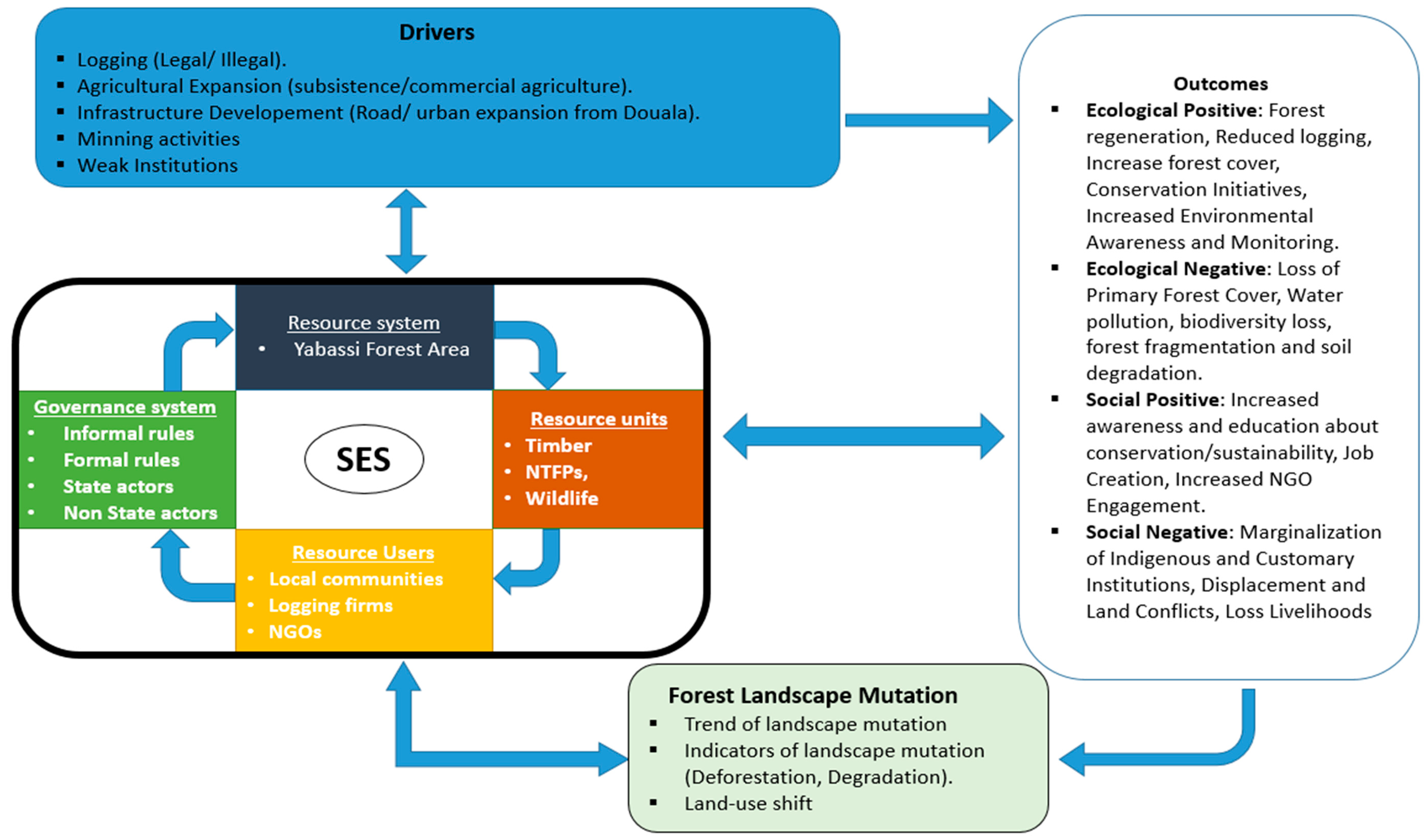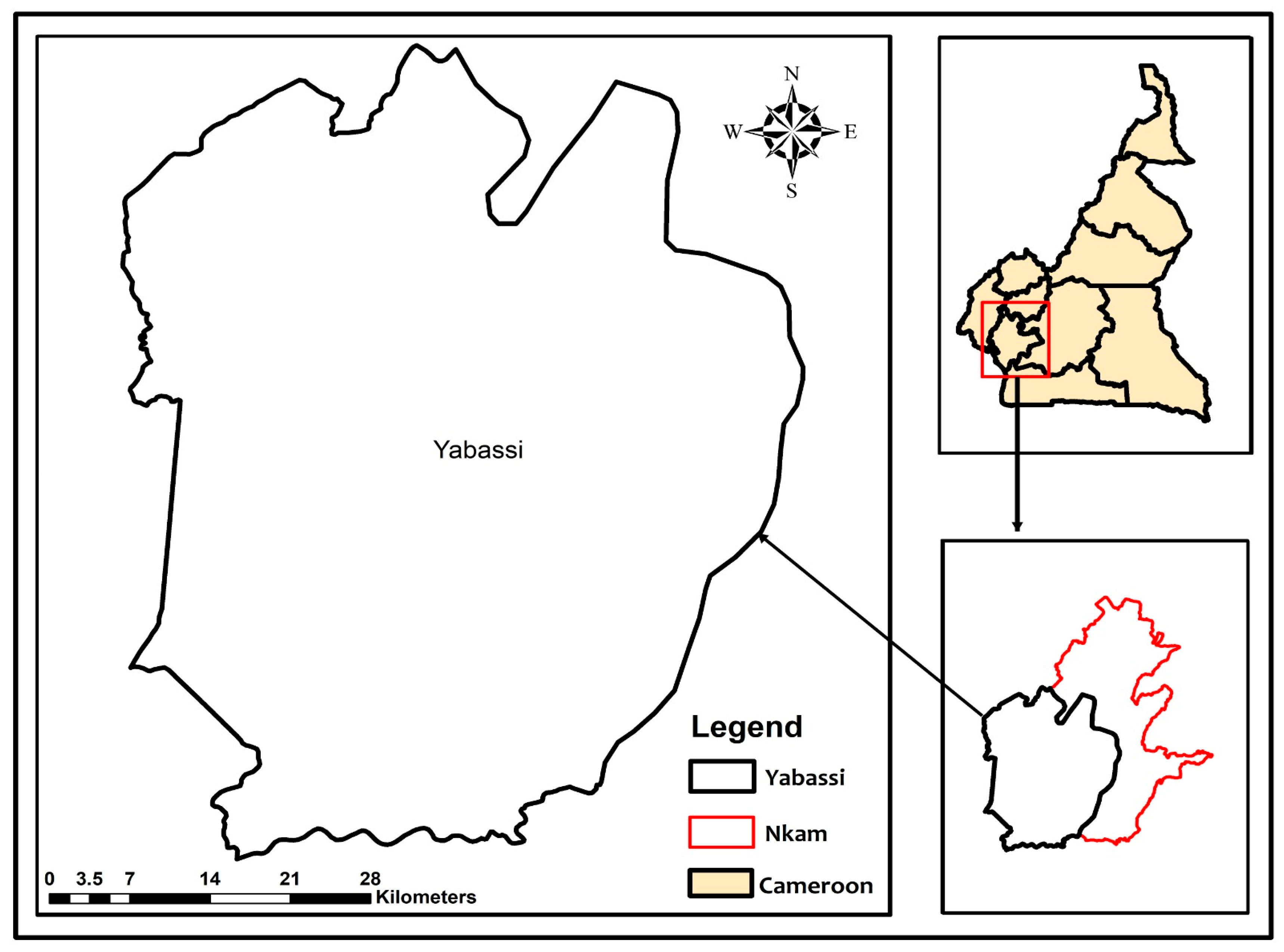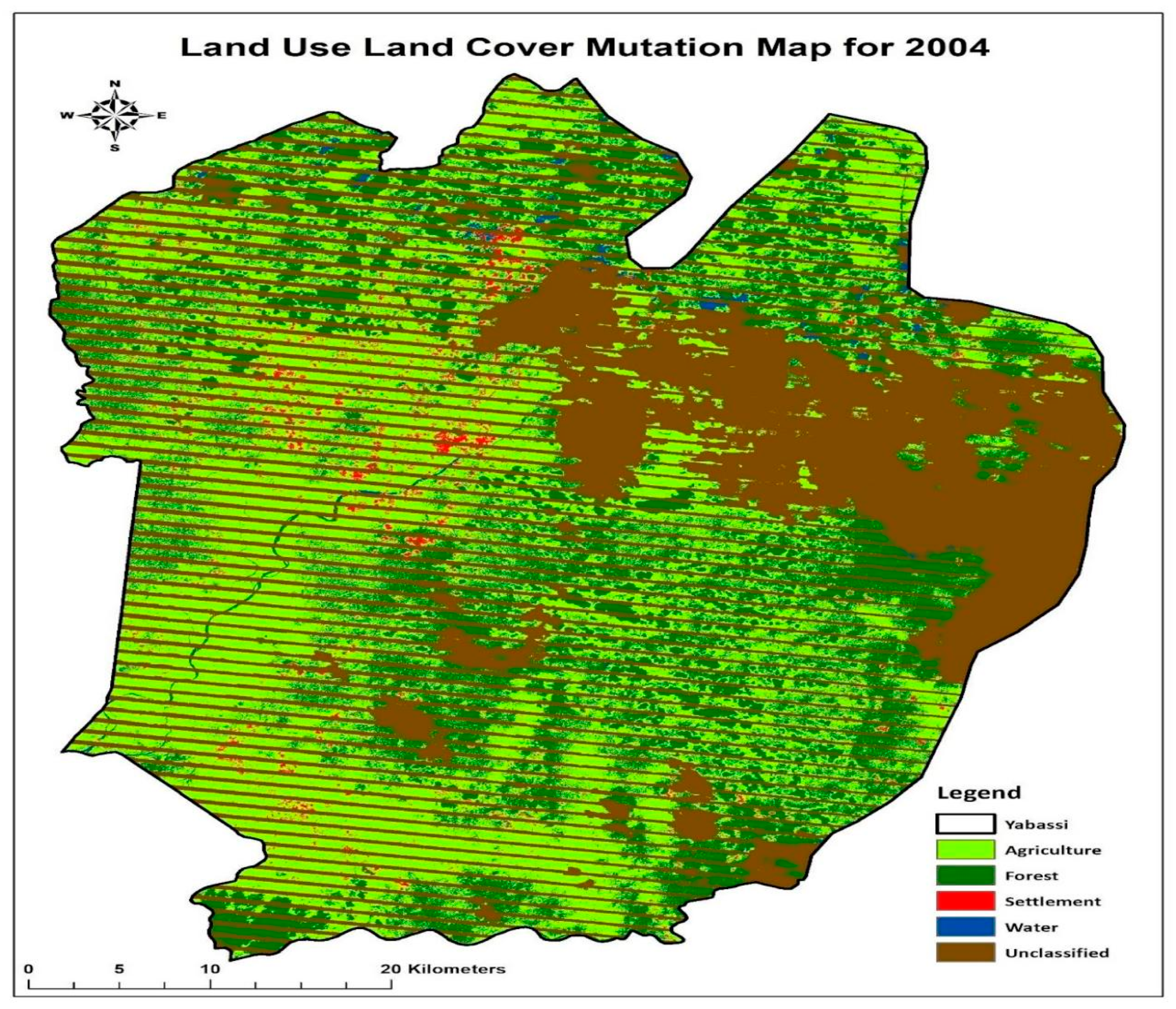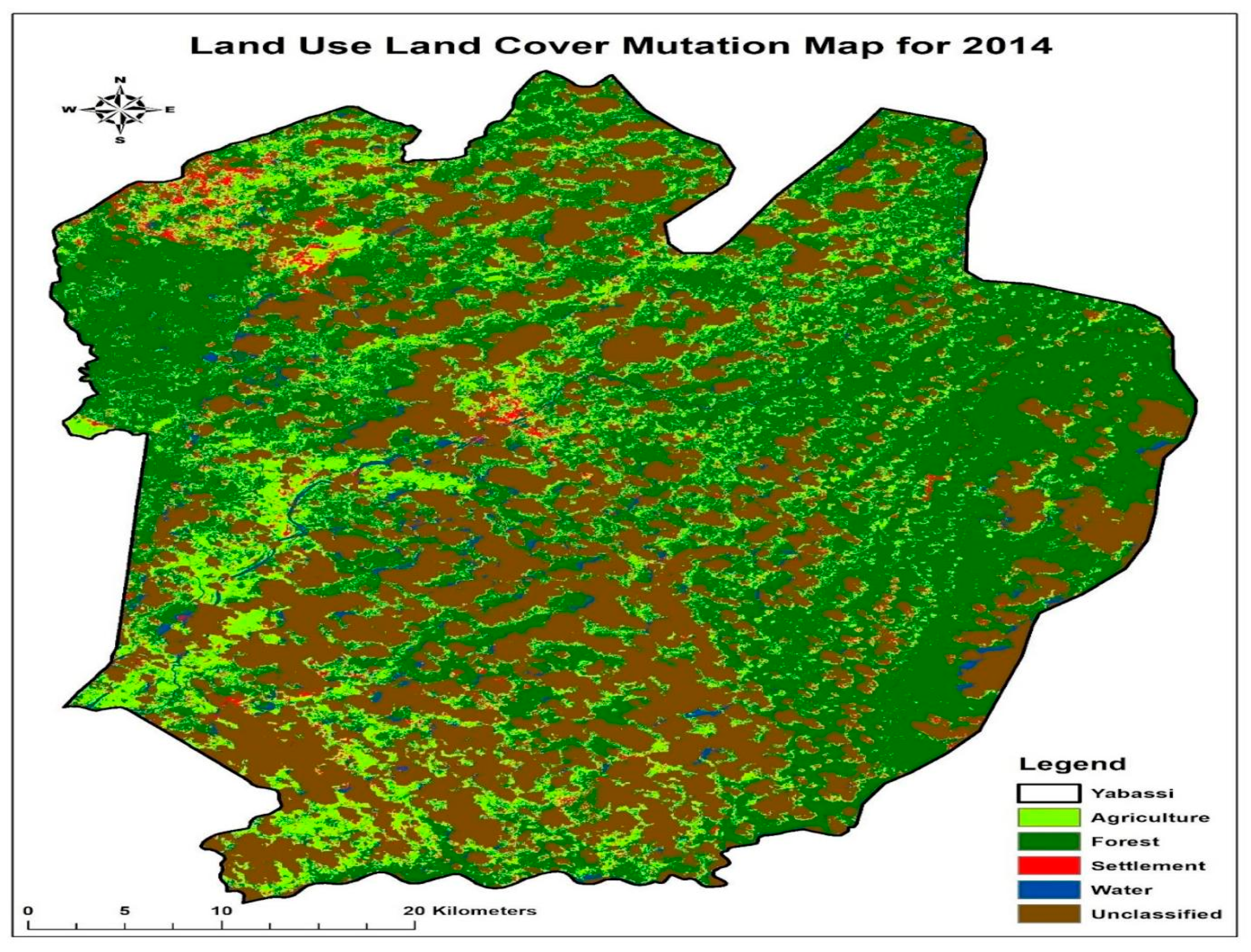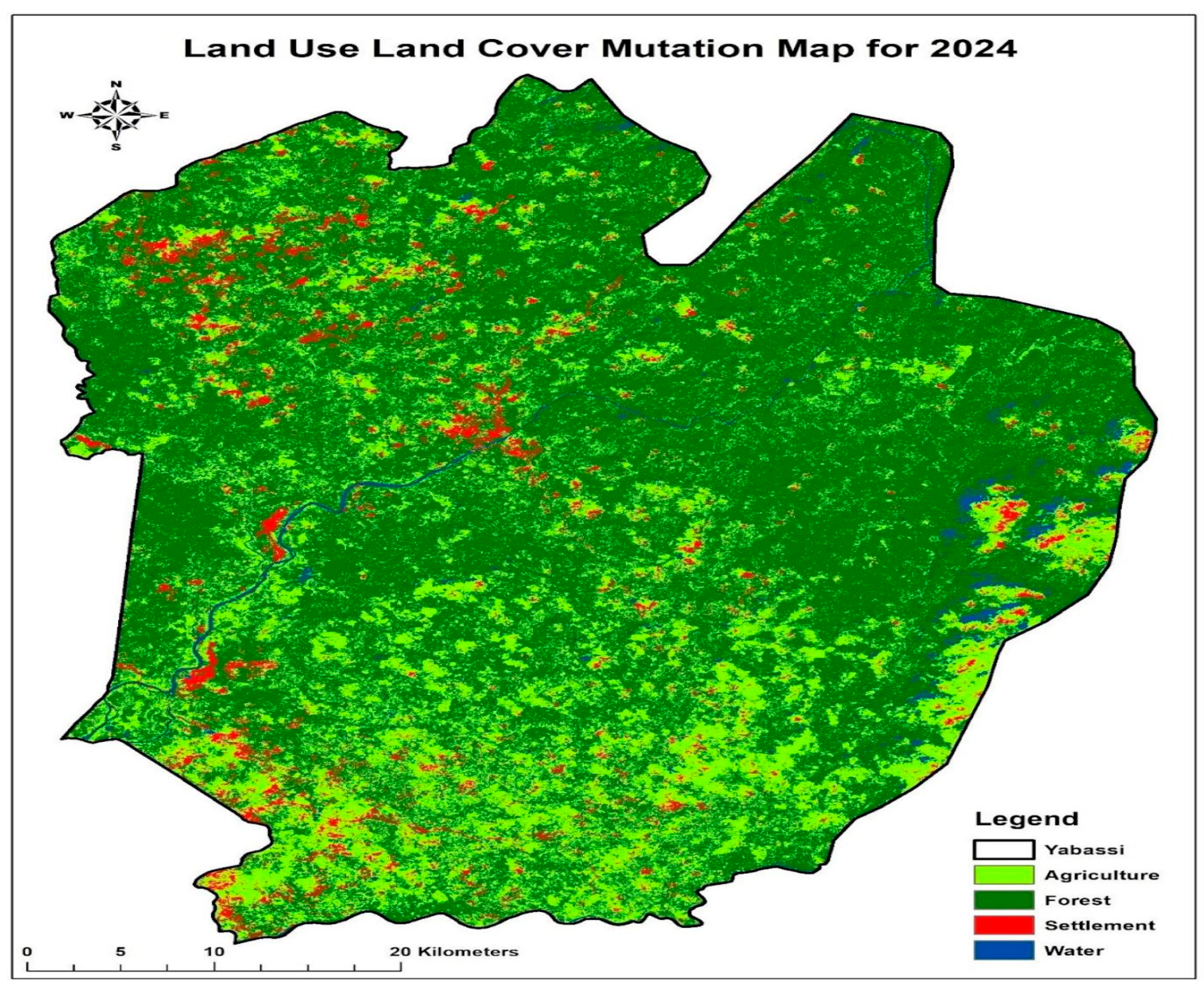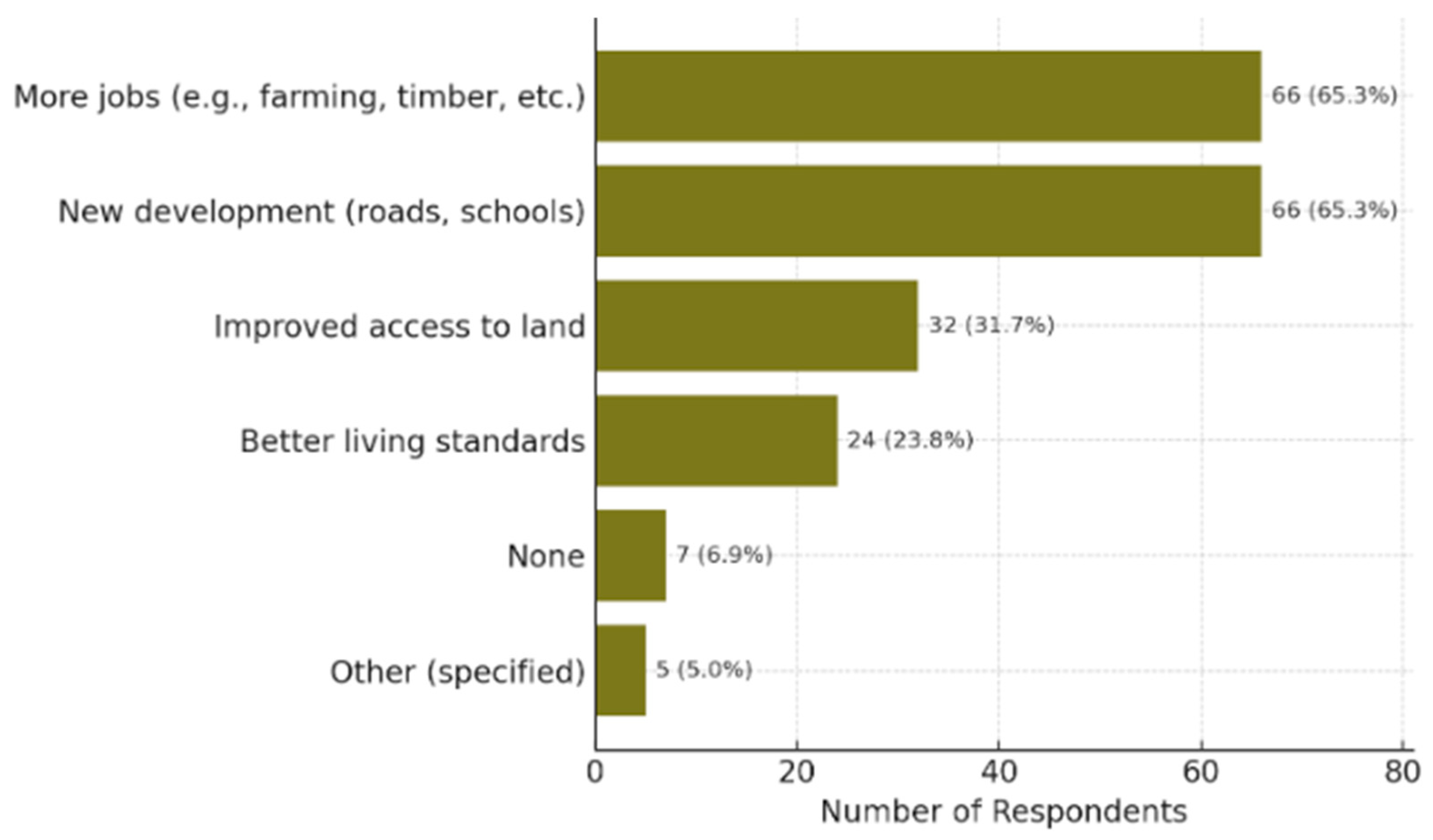1. Introduction
Forest ecosystems worldwide are undergoing profound transformations driven by a complex interplay of anthropogenic pressures and environmental changes. At the heart of these transformations are forest management institutions (FMIs), which play a pivotal role in mediating the access, use and conservation of forest resources. The functionality, design, and enforcement capacities of these institutions remain central themes in academic discourse as scholars seek to unravel the dynamics that underpin compliance and sustainability in forest governance systems [
1,
2,
3]. Expanding global comparative research remains vital to enhance our understanding of how FMIs are formulated and how they respond to socio-ecological challenges [
4].
A key concern within this context is forest landscape mutation. This term encapsulates the long-term transformation of forested areas through substantial land use, ecological structures and land cover changes. These shifts, primarily triggered by logging, agricultural expansion, mining, infrastructural development and climate change, undermine forest integrity and ecosystem service functions [
5,
6,
7]. Globally, forest degradation and deforestation is alarming; recent data reveals an unsettling reversal in conservation gains. In 2023, 6.37 million hectares of forest was cleared. This renders the target to halt global deforestation by 2030 quite daunting [
7]. With carbon emissions from deforestation reaching 3.8 billion metric tons of CO
2 equivalent and more than 62 million hectares of ecological downgraded, forest mutation now constitutes a global ecological emergency.
Agricultural expansion remains the foremost driver of forest change worldwide. In the Congo Basin, which has the second-highest forest cover after the Amazon, more than 90% of deforestation is attributed to land conversion for agricultural purposes [
8]. Although similar processes occur in Latin America and Southeast Asia, Africa is considered as the region with the highest net forest loss globally, averaging 3.94 million hectares annually between 2010 and 2020 [
9]. In sub-Saharan Africa (SSA), small-scale agriculture for domestic markets, along with informal logging and mining, exacerbates forest fragmentation and ecological degradation [
10,
11].
The outcomes of forest landscape mutations in SSA are intimately linked to structural governance deficits that affect the ecological change process and limit community adaptation. According to [
9], we experienced the highest net forest loss globally between 2010 and 2020. This intensified soil erosion, leading to an increase in water insecurity and degradation of ecosystems that are crucial for livelihoods and climatic moderation. Beyond biophysical degradation, these transformations jeopardize progress towards attaining global environmental commitments. Ref. [
12] argues that unchecked forest mutations across SSA derail efforts to meet climate mitigation goals and biodiversity conservation targets, particularly under frameworks such as the REDD+ and the Aichi Targets.
In another dimension, the negative socio-ecological impacts of forest landscape mutations are not uniform. A growing body of research highlights the role of local resilience and community innovations in adapting to and mitigating landscape disruptions. For instance, Ref. [
13] documents how communities under secured forest tenureship engage in ecologically beneficial practices such as agroforestry, selective harvesting, and community reforestation. These adaptive responses underscore the fact that outcomes do not hinge solely on environmental issues but equally manifest through institutional arrangements. When governance systems are locally embedded, participatory, and responsive, they can act as buffers against the adverse impacts of forest degradation. Nonetheless, persistent challenges such as institutional fragmentation, overlapping jurisdictions, and elite capture continue to weaken governance capacity [
13]. These obstacles dilute accountability and limit the effectiveness of community-based interventions. Therefore, understanding the interplay between governance quality and forest mutation outcomes is essential for designing regionally tailored, equity-oriented forest conservation strategies in the Congo Basin, with Cameroon being a classical example.
Cameroon exemplifies the tensions between the conservation of forest landscapes and socio-economic development, with forests covering approximately 42% of its territory [
6]. Smallholder farming, illegal logging, and artisanal mining have led to an annual forest loss of 1.3% between 2010 and 2020 [
6,
7]. The Yabassi forest, part of the ecologically significant Ebo Forest landscape, has witnessed accelerated degradation as exemplified by is significant natural forest cover decline [
14]. Cameroon’s 1994 Forestry Law introduced progressive mechanisms such as Community Forest Management (Section 37) and Logging Rights for Local Populations (Section 57), designed to align sustainable resource use with local development. Even the recent 2024 Forestry and Wildlife Law further emphasized these issues. Although these frameworks have shaped positive socio-ecological outcomes, challenges linked to weak enforcement, exclusionary regulations, and inequitable benefit sharing still exacerbate forest governance [
15,
16,
17]. The above issues validate the need for context-specific evidence to uncover governance questions in the context of forest landscape mutations, with the Yabassi Forest Area being a valid case.
Questions on forest landscape mutations in the Yabassi Forest Area remain less understood with emphasis on its spatiotemporal dynamics and the socio-ecological transformation-cum-outcomes linked to the process. The evidence is useful in providing insights to edify the SES framework and challenges the mainstream position on forest decline by highlighting areas of recovery. The evidence also informs forest management policy with emphasis on adaptive forest governance processes in the Congo Basin and similar contexts.
2. Research Methods
2.1. Analytical Framework
This study is grounded in the socio-ecological systems (SES) framework, which provides a holistic lens for analyzing the dynamic interactions between human and ecological subsystems [
18]. The SES framework integrates ecological processes, resource use patterns, governance structures, and social behaviors into a single analytical structure. By adapting the SES framework to the context of the Yabassi Forest Area, the study conceptualizes forest landscape mutation not merely as physical land cover change but as a multi-scalar and multidimensional transformation shaped by interlinked ecological, socio-economic, institutional, and governance drivers.
The analytical model employed (
Figure 1) maps the interplay between core components of the SES resource systems (forests), resource units (timber, NTFPs, biodiversity), actors (local communities, loggers, state agencies), and governance systems (formal forestry laws, customary norms, NGOs). This also captures both proximate and underlying drivers of landscape mutations. The drivers interact with biophysical feedback and institutional responses, resulting in distinct socio-ecological outcomes—both negative and positive.
The Yabassi Forest Area has experienced significant structural and functional shifts in land cover due to logging, agricultural encroachment, mining, and infrastructural development [
19]. Forest cover declined by more than 30% between 1990 and 2020, with an estimated annual deforestation rate of 1.3% between 2010 and 2020, primarily in the southern and eastern zones adjacent to the Douala–Yabassi corridor [
20,
21,
22]. These zones are marked by expanding road networks, illegal logging routes, and encroaching settlement frontiers.
The SES framework allows for a nuanced exploration of the drivers of forest landscape mutations, including:
Logging (legal and illegal): More than 60% of the residents perceive illegal logging as the dominant threat, driven by enforcement failures and corruption [
23,
24].
Agricultural expansion: Both subsistence and commercial farming (cassava, cocoa, oil palm) have led to a 45% increase in cultivated area, replacing vital forest cover in high-pressure zones [
23].
Infrastructural development: Logging firms and urban sprawl from Douala have tripled the regional road network since 2000, facilitating deeper forest penetration [
24].
Mining: Informal gold and gravel extraction led to river sedimentation, ecological fragmentation, and biodiversity loss, particularly affecting freshwater ecosystems [
22].
Governance fragmentation: Weak institutional capacity, overlapping mandates, and elite capture reduce policy effectiveness and allow unsustainable land use practices to flourish [
25].
The interactions yield varied socio-ecological outcomes. Some of the ecological outcomes include deforestation, biodiversity loss (e.g.,
Kupeantha yabassi,
Louisea yabassi), soil erosion, and hydrological disruption [
22,
25,
26]. However, secondary forest regeneration and increased conservation awareness are championed by NGO campaigns to counter these threats in zones with reduced disturbance. The social outcomes include livelihood disruption, cultural erosion (especially loss of access to sacred groves), gendered inequalities in resource access, and land use conflicts among stakeholders. The influx of labor migrants linked to extractive industries led to an increase in social fragmentation. However, some communities have benefited from short-term employment in logging and agriculture and have engaged in participatory governance through village forest management committees (VFMCs) and NGO partnerships (e.g., AJESH).
By embedding these dynamics within the SES framework, the study captures the non-linear, feedback-driven nature of forest landscape mutation in Yabassi. It emphasizes that the outcomes are not simply a product of environmental pressures but are fundamentally shaped by governance quality, actor interactions, and institutional adaptability. Thus, the framework provides an integrated platform for evaluating the resilience or vulnerability of forest landscapes, offering insights that can inform policy reform and community-led conservation strategies in the Congo Basin and similar contexts.
2.2. Study Area
This study was conducted in the Yabassi Forest Area, a 300,000-hectare landscape located in Cameroon’s Littoral and Central Regions, specifically in the Nkam and Mbam Divisions (
Figure 2). The area comprises three ecologically significant forest blocks: the Ebo Forest (141,700 ha), the Ndokbou Forest (100,000 ha), and the Makombe Forest (60,000 ha) [
23]. As part of the Guineo–Congolian rainforest belt, the region is recognized as a Key Biodiversity Area, home to more than 310 bird species and several endangered mammals, including the western gorilla (
Gorilla gorilla), chimpanzee (
Pan troglodytes), drill monkey (
Mandrillus leucophaeus), and forest elephant (
Loxodonta africana) [
22,
25]. The forests span an altitudinal gradient of 9 to 1304 m and are characterized by high rainfall and a mosaic of microhabitats. Despite its ecological value, the region faces growing development pressure, though conservation victories such as suspending a proposed logging concession in Ebo Forest in 2020 have highlighted its strategic importance [
27]. The forest landscape is bordered by more than 40 communities, including indigenous Banen populations, whose livelihoods are based primarily on subsistence agriculture. As of 2018, the area had a population of 17,127. Poor infrastructure and limited road access have contributed to the area’s conservation value and governance challenges in the forest [
28].
The study area covers approximately 300,000 hectares, representing the generalized boundary of the target landscape. However, the total area analyzed varies slightly across different components of the study due to the application of specific data masks and inclusion criteria. During land use/land cover (LULC) classification, all valid pixels within the defined study boundary were included, resulting in a total classified area of approximately 308,765 hectares. This slightly exceeds the nominal study area due to pixel-level inclusion along boundaries and within an irregular geographic extent. In contrast, the transition matrix analysis includes only pixels with valid classification in both time periods. As a result, unclassified, cloud-covered, or masked pixels—due to sensor limitations or quality filtering—were excluded, reducing the total analyzed area to approximately 268,701 hectares. Such variation is common in remote sensing-based landscape analysis, where differing pixel availability and data quality across time periods necessitate conservative inclusion criteria to ensure reliable change detection. All area-based calculations and percentage changes reported are internally consistent within each analysis.
2.3. Research Design and Data Collection
The study adopts a mixed-methods design guided by an explanatory sequential model to examine the patterns and impacts of forest landscape mutations. The research began with a spatial analysis to quantify forest change over 20 years (2004–2024), followed by household surveys to assess local perceptions and socio-ecological outcomes. This integration allowed for triangulation between observed land use dynamics and community experiences, providing a more robust and policy-relevant understanding of the phenomena under study.
Spatial data were derived from Landsat satellite imagery (Landsat 7 ETM+ for 2004, Landsat 8 OLI for 2014, and Landsat 9 OLI-2 for 2024), sourced from the USGS Earth Explorer. Supervised image classification was conducted using ArcGIS 10.8 to categorize land cover into five classes: dense forest, degraded forest, agricultural land, settlements, and water bodies. Google Earth Pro was used to extract geographic control points (GCPs) for classification support. The land use and land cover analysis was conducted using Landsat imagery obtained from the United States Geological Survey (USGS). Each image had a spatial resolution of 30 m, which is suitable for detecting medium-scale landscape changes in forested environments. The selected images corresponded to the dry season months, thus reducing cloud interference and cover for 2004 (Landsat 5 TM), 2014 (Landsat 8 OLI), and 2024 (Landsat 9 OLI-2). At the same time, field verification was carried out between March and May 2024 across selected communities in the three forest blocks. These observations, combined with historical land use narratives, improved classification reliability. Ground truthing was employed to enhance accuracy in mapping complex land cover transitions, as recommended by Foody [
29], while change detection analysis was subsequently applied to quantify forest loss and gains, and to identify the spatial patterns of landscape mutation.
To complement the geospatial analysis, a structured household survey was implemented to assess community-level socio-ecological outcomes. The survey instrument contained 18 closed-ended questions across four domains: demographics, environmental changes, ecological impacts, and social impacts. The survey targeted residents of the Yabassi Forest Area who are actively engaged in forest-dependent activities such as farming, hunting, and NTFP collection.
The sample was selected using a stratified random sampling approach to improve representativeness. Eight villages were selected across the three forest blocks—Ebo (Iboti, Bekob, Logdeng), Ndokbou (Ndokbou I, Ndokbou II), and Makombe (Milombe, Balam, Moya)—based on their proximity to the forest and active reliance on forest resources (
Table 1). Within each village, households were randomly selected using a raffle-draw method adapted to linear settlement patterns. The number of households surveyed in each village was proportional to its estimated population and settlement density, helping to ensure equitable spatial coverage. A total of 100 households were surveyed, representing approximately 0.6% of the estimated population. While this proportion may appear low, the sampling fraction of 5–10% was assured for each community.
Data collection occurred in two phases. In March 2024, preliminary visits and interviews with two traditional leaders were carried out to identify key forest governance structures and validate the survey design. From March to May 2025, the second phase involved the full deployment of surveys by two research assistants who could communicate in English and French. Before administering the questionnaire, community sensitization sessions were held to explain the study’s purpose and ensure informed consent. Participation was voluntary, and confidentiality was maintained throughout the process.
To ensure contextual relevance and adaptation to logistical constraints, the survey design process included a pre-testing phase conducted in December 2024. During this period, the research team visited selected communities within the Yabassi Forest Area to pre-test survey instruments, engage with local leaders, and assess the feasibility of various distribution methods. This process informed the refinement of the data collection instrument and the choice of the online survey approach. The online survey was conducted with the support of community focal points and civil society organizations who helped circulate the survey and assist less digitally literate participants. To reduce sampling bias, the study targeted forest-dependent households with known engagement in farming, hunting, and/or non-timber forest products (NTFPs) collection. While some remote households may have been underrepresented due to digital access limitations, outreach was broadened through local mobilization and the involvement of trained field assistants who provided guidance where needed. Survey results were triangulated with spatial analysis and key informant interviews, strengthening the validity of the findings.
2.4. Data Analysis
This study adopted a mixed-methods approach combining spatial analysis and household survey data. Land use and land cover (LULC) classifications were derived from multi-temporal satellite imagery using supervised classification techniques. Accuracy assessment was performed using the ENVI 4.5 software, with standard metrics such as overall accuracy and Cohen’s kappa coefficient applied to evaluate classification performance across 2004, 2014, and 2024. For the household survey, responses were coded and analyzed using Microsoft Excel. Descriptive statistics (frequencies and percentages) were used to summarize trends related to forest changes, socio-ecological impacts, and governance perceptions. Graphs and charts were used to visualize patterns, while thematic analysis guided the interpretation of open-ended responses.
All results were interpreted using the socio-ecological systems (SES) framework [
18], which enabled the structured analysis of four key components: resource systems (forest landscapes), resource units (timber, wildlife, NTFPs), users (households, traditional authorities, private firms), and governance systems (customary laws, state regulations, community forest committees). Through this integrative and systems-oriented approach, the study offers a grounded understanding of the ecological and social outcomes of forest landscape mutations, generating theoretical and action-oriented insights for conservation and rural development in the Congo Basin.
2.5. Accuracy Assessment of Image Classification
To assess the accuracy of land use and land cover (LULC) classifications, the classified outputs were validated using ground control points from preliminary field visits and remote validation with high-resolution satellite imagery. Accuracy assessment was conducted with the ENVI 4.5 software using standard metrics, including overall accuracy and Cohen’s kappa coefficient [
30]. The results indicated moderate classification performance, with kappa values of 0.54, 0.46, and 0.65 and overall accuracies of 73.02%, 60.44%, and 73.85% for the years 2004, 2014, and 2024, respectively (
Table 2). Earlier years exhibited a significant fraction of unclassified pixels—41.87% in 2004 and 32.16% in 2014. This was mainly due to cloud cover, image noise, and spectral confusion. However, improvements in image resolution and classification techniques by 2024 eliminated the unclassified category entirely, enhancing reliability. In addition to remote sensing data, the study incorporated ancillary socio-economic, demographic, and policy information sourced from government agencies, research institutions, and existing literature. These contextual datasets provided insights on the drivers of land use and land cover change such as governance reforms, evolving livelihood practices, and infrastructural growth in the Yabassi Forest Area, in line with the recommendations of [
31].
4. Discussion
The Yabassi Forest Area, situated within the Congo Basin, offers an insightful case of socio-ecological transformations shaped by two decades of dynamic forest landscape mutations. Using the socio-ecological systems (SES) as analytical framework [
18], this study illustrates how interactions between resource systems (forests), resource units (biodiversity and land cover types), governance systems (local and state institutions), and users (communities and actors such as NGOs) collectively produce a set of positive and negative socio-ecological outcomes.
To deepen the SES framework, this study anchored its findings to the core components of the SES framework. The forest landscapes of Ebo, Ndokbou, and Makombé serve as distinct resource systems (RS), each exhibiting different forest cover trends and land use pressures. Within these systems, households engage with various resource units (RU)—including timber, NTFPs, wildlife, and medicinal plants—based on livelihood needs and cultural practices. These interactions are mediated by a diverse array of actors (A) such as herbalists, hunters, and women, many of whom face limitations in access and decision-making power. The governance system (GS) encompasses both formal institutions (e.g., forestry laws and NGO interventions) and informal mechanisms (e.g., traditional rules and community bylaws). Reported participation in conservation activities (66%) alongside low perceived governance effectiveness (29%) highlight tensions within this system. Through activities like farming, hunting, and forest product collection, these actors engage in interactions (I) that lead to key outcomes (O) such as perceived forest decline (95%), biodiversity loss (90%), land conflicts (67%), and importantly local observations of forest regeneration (30%). The core contribution centers on the observed positive and negative ecological and social outcomes linked to the changes in the resource system (socio-ecological system). This enhances the understanding of how governance failures, livelihood dependencies, and ecological pressures have co-evolved in shaping the Yabassi forest landscape.
Between 2004 and 2024, Yabassi experienced a notable increase in forest cover, from 22.85% to 68.65%, representing a net gain of more than 45%. This net gain is accounted for, in part, by the sustained ecological interventions such as agroforestry, enrichment planting, and farmer-managed natural regeneration of state actors and NGOs. This affirms the SES proposition that resilient outcomes are possible when institutional arrangements (e.g., community forestry) align with local ecological knowledge and incentives. These findings align with the work of the author of [
33], who observed that community-led forest governance in Cameroon enhances the success of reforestation and ecological stewardship. However, this contrasts with that in [
34], which argued that conservation interventions often fail to deliver long-term environmental benefits in Central Africa due to institutional fragmentation and inconsistent policy enforcement. The Yabassi case, however, suggests that where multi-actor governance is coordinated and socio-ecological feedback is recognized, achieving significant recovery is possible.
While the study recorded a +151% increase in forest cover between 2004 and 2024, it is important to note that this finding does not align with regional and global trends, which generally report net forest loss across Cameroon and other parts of the Congo Basin. For instance, Refs. [
6,
9] highlight persistent deforestation in the Congo Basin due to agricultural expansion, logging, and infrastructure development. However, the results reflect localized landscape dynamics within the Yabassi Forest Area and should not be generalized as indicative of national or continental trends.
Several contextual factors help explain the observed forest gains. First, passive regeneration of formerly cultivated or abandoned farmland—particularly in areas affected by shifting livelihood strategies and population mobility—contributed to the natural recovery process of forested areas. This mirrors regeneration trends observed elsewhere in Central Africa [
35]. Second, the Yabassi Forest Area partially overlaps with Key Biodiversity Areas (KBAs), where targeted community-based conservation initiatives have played a critical role. A notable example is the suspension of a proposed logging concession in the Ebo Forest (141,700 ha) in August 2020 by the government of Cameroon. This decision came in response to stiff opposition from local communities, environmental NGOs, scientists, and international partners, who highlighted the forest’s global ecological significance and its role in supporting endemic and endangered species, such as the Nigeria–Cameroon chimpanzee and forest elephants. The government issued a public statement revoking the decree to allocate the concession. This helped to avert large-scale forest clearance and reaffirmed the value of community and civil society engagement in forest governance [
36]. The intervention has since enabled continued forest recovery and strengthened the foundation for biodiversity conservation and local stewardship in the region. Third, certain blocks, particularly portions of the Makombé Forest, have remained relatively inaccessible due to topographic and infrastructural constraints, limiting commercial exploitation and preserving forest integrity. Last, the apparent forest gains may be partially attributable to improved classification methods in 2024, including higher-quality satellite imagery and the elimination of the “unclassified” category, which enhanced the visibility and detection of secondary forests and regenerating woodlands previously masked by cloud cover or spectral confusion.
It is evident that there has been a net gain in forest cover within this landscape. However, the reported +151% increase in forest cover between 2004 and 2024 should be interpreted with caution, as it may partially reflect classification differences rather than the true ecological change. Classification accuracy was notably lower in the earlier years (overall accuracy: 73.02% in 2004; 60.44% in 2014) compared to 2024 (73.85%), with high proportions of unclassified pixels in 2004 (41.87%) and 2014 (32.16%), and none in 2024. These discrepancies indicate that improved image quality and classification techniques in 2024 likely contributed to the forest gain estimate, because it reduced omission errors and expanded the detectable area. While a formal error-adjusted area estimation [
37] was not applied, the study now incorporates this limitation in the interpretation and recommends such methods for future research to derive more robust change estimates.
The observed mutations in forest landscapes underscore the volatility of agricultural land use, which declined sharply by 50.72% between 2004 and 2014 before witnessing a partial rebound by 2024. Agriculture has thus acted both as a driver and a recipient of land use change, confirming its role as a core feedback variable within the SES framework. This finding aligns with [
28], who emphasized the bidirectional nature of agricultural pressure and forest transformation in Cameroon. It also reflects broader African trends, where shifting cultivation, market-driven farming, and tenure uncertainty destabilize landscapes [
9]. These dynamics challenge [
38], which projected a linear decline in forest cover under expanding agricultural fronts, underestimating the potential for forest regeneration under hybrid land use regimes.
The drivers of forest landscape mutations in Yabassi, mainly population growth (57%), agricultural expansion (56%), logging (48%), and urban development (48%), further illuminate the complex interplay of ecological and social subsystems. These pressures mirror patterns found elsewhere in the Congo Basin, where demographic trends and infrastructural development amplify land conversion. Interestingly, the perceived effects of climate change (36%) were also identified as a key driver, particularly through its effects on rainfall variability and soil productivity, which redefine local land use decisions. These findings support [
39], which demonstrated that vulnerability to climate variability accelerates land transitions in rural forest communities. However, they differ from [
40], which rather emphasized the dynamics of global commodity markets. In the Yabassi Forest Area, shifts in rainfall patterns, rising temperatures, and increased frequency of extreme events have altered species distribution, promoted pest outbreaks, and increased the risk of fire—ultimately degrading biodiversity and disrupting key ecosystem services such as water regulation and soil retention. Studies elsewhere support these concerns; for example, Ref. [
41] observed that in Southwest China, climate change contributed to water yield reduction (84%) and to variations in soil conservation (91%), thus surpassing the impacts of land use change [
42]. These changes in ecosystem service provision highlight the scale-dependent uncertainties that climate variability introduces, particularly for water-related functions. These local observations are consistent with broader regional and global patterns of climate-induced forest change. Recent studies further highlight how climate change reshapes forest landscapes and ecosystem services through linked drivers such as fires, drought, and biodiversity loss. For example, climate-induced shifts in species composition and forest structure are becoming increasingly common, as warmer and drier conditions promote more frequent and intense fires while reducing the resilience of late-successional forest ecosystems [
43,
44]. Drought-induced mortality alters species composition and reduces carbon storage in forest biomass; this creates potential feedback loops within the climate system [
45,
46]. In tropical forests like the Amazon, increased drought and fire risks may shift ecosystems toward more fire-prone and biodiversity-poor savanna states [
47,
48]. These findings underscore the importance of integrating climate resilience into forest management and conservation planning in Yabassi and similar forest systems worldwide. In the Yabassi context, where livelihoods depend on forest-derived ecosystem services, promoting ecosystem-based adaptation strategies, improving forest monitoring systems, and integrating climate resilience into conservation planning are essential.
The socio-ecological outcomes of forest transformations have been both enabling and exclusionary. On the ecological front, gains in forest cover were associated with forest regeneration (30%), perceived biodiversity conservation (25%), and increased opportunities for ecotourism (8%). These benefits demonstrate how landscape-level interventions can enhance ecosystem integrity and unlock new economic opportunities, particularly when combined with community engagement. Yet the legacy of earlier forest loss is still deeply felt. Wildlife decline was reported by 75% of respondents, while 76% reported a decline in biodiversity. This dissonance between quantitative forest gains and qualitative ecological degradation challenges simplistic metrics of conservation success, supporting [
26], which argues that forest integrity, not just extent, is the true determinant of ecological resilience in the broader Congo Basin.
Socially, the positive outcomes of increased employment (66%), improvement in infrastructure (66%), and improved land accessibility (32%) were widely reported. These align with the SES emphasis on livelihood diversification as a component of resilience. Yet, these benefits were accompanied by deepening inequality and dispossession. Loss of traditional access (69%), rising land conflicts (67%), and migration due to deteriorating conditions (13%) highlight the social costs of forest mutations. This supports [
49], which documented how conservation gains in Central Africa often coincide with social marginalization when tenure rights are weak or undefined. It also contradicts [
50], which contended that forest transitions in community-managed landscapes in Cameroon are socially beneficial. In Yabassi, it is evident that without equitable governance, forest recovery can coincide with socio-spatial exclusion.
The implications of these findings for policy are profound. First, adaptive forest governance must move beyond ecological indicators to encompass social equity, livelihood security, and cultural access. Recognizing customary tenure, supporting agro-ecological transitions, and investing in inclusive monitoring systems remain crucial for success. Second, landscape management must be context-specific and flexible, integrating local knowledge and feedback into decision-making processes. Third, regional planning should anticipate and mitigate the unintended consequences of infrastructure and demographic growth factors that can undermine forest resilience.
In summary, the Yabassi case provides both caution and promise. It shows that forest recovery is possible but not inevitable, that ecological gain can coexist with social fragmentation, and that policy success lies not in technocratic fixes but in participatory, system-aware governance. As a microcosm of broader Congo Basin dynamics, Yabassi reveals the importance of aligning conservation goals with socio-ecological realities to ensure sustainable and just forest futures.
